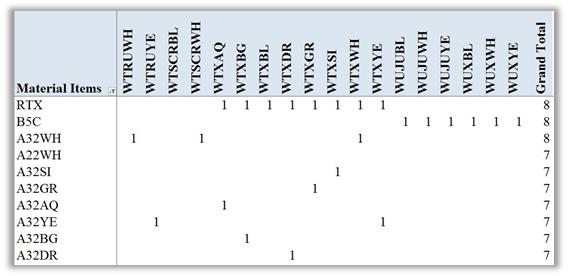So, what is a matrix bill of materials, and why is it important?
A matrix bill of materials, or matrix BOM, is typically presented as a grid with produced items across the top of the grid and raw materials as row headings. See the accompanying figure for an example.
A '1' or a hash mark in the grid at the intersection of the raw material (row) and produced item (column) indicates that the raw material is a component in the correlated finished good. The raw material may be a component at any level in the BOM for the finished good—not necessarily only in level 1.
Why is a matrix BOM an important tool?
While "tribal knowledge" within your organization can likely identify those inventory items that are used in lots of end-items, tribal knowledge is probably less clear on precisely which end-items are correlated to which raw materials. The specifics are more difficult to pinpoint than are the generalities.
However, in order to calculate with reasonable accuracy the return-on-investment (ROI) value of stocking specific quantities of any given raw material, it is essential to know, not only how many finished goods are affected, but also which finished goods are affected. After all, not all finished goods are created equal. Some finished goods are more profitable than others; some finished goods have greater demand than others; some finished goods have shorter customer tolerance times than others; and, some finished goods have greater variability in demand than others. All of these factors play into calculating the ROI of carrying specific supporting inventories.
Leverage points
A glance at the accompanying excerpt from a matrix BOM tells us at once that raw material items 'RTX' and 'B5C' are consumed in the production of eight (8) different end-items. When seeking to maximize the ROI on your inventory investment dollar, carefully evaluating the impact of inventories of raw materials beginning with those that affect the greatest number of end-items and / or largest demand is an excellent place to start. The matrix BOM gives you a clear picture of the order in which to begin your evaluation for maximizing the leverage of your inventory investment dollars.
Many systems do not offer a matrix bill of materials out-of-the-box. Nevertheless, with many databases, it is not too difficult to produce one. The figure shown was produced from a Sage 500 ERP system using a Transact-SQL data view using the with cube function, and a Microsoft® Excel™ spreadsheet, where the pivot table capabilities were employed.
Please leave your comments or questions below. Do you have a matrix bill of materials available to you? How do you leverage your inventory investment dollar to maximize your ROI?




